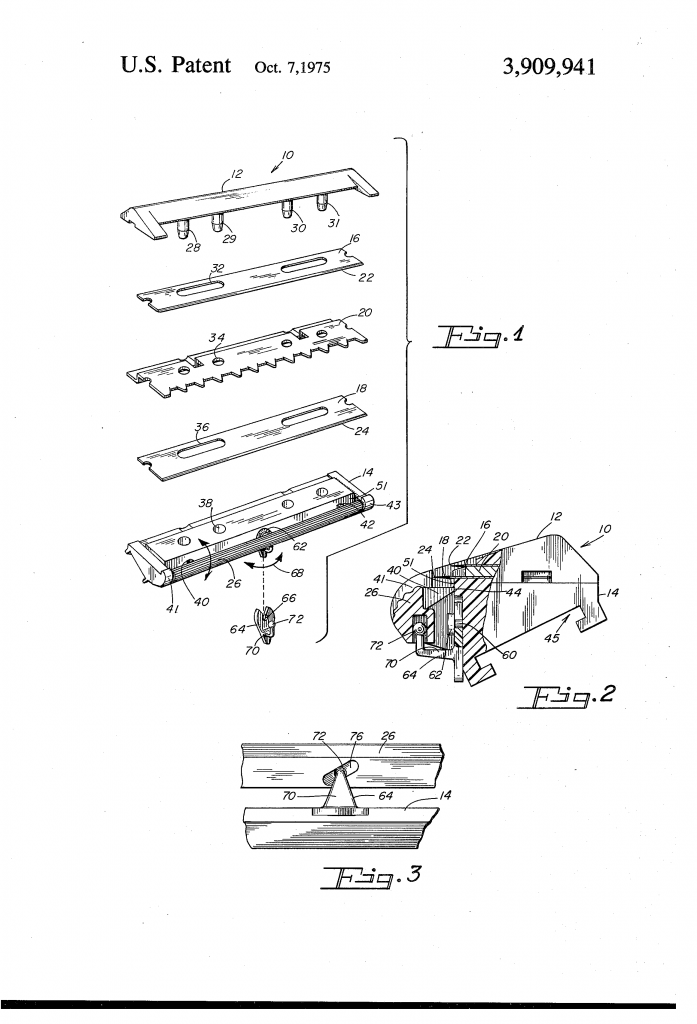There are a couple of common ways to make an adjustable safety razor. You can change the distance between the top cap and bottom plate, like the Gillette adjustable razors do. You can change the blade curvature, as done in the Rockwell and others. Or you can opt for the much less common idea of moving the guard back and forth, like J E Fuller’s 1890 patent hints at.
It was this less common way of doing things that features in Peter Bowman and Ernest F Kiraly’s patented adjustable safety razor. The application was filed in 1974, and granted the year after. The most novel thing is how adjustability was controlled.
Concept of adjustability
The concept is simple – at least in principle. Lets see how the patent describes it first, before translating to layman terms.
…e. a plurality of flexible plastic webs integrally formed with and interconnecting said blade seat member and said guard structure, said webs defining a transverse hinging axis parallel to said skin-engaging surface, f. a linear channel formed in an underside of said guard structure, said channel being nonparallelly disposed with respect to said hinging axis, and g. a manually operable cam mounted on said blade seat and movable about a forwardly directed axis, said cam including a portion extending forwardly to beneath said channel and another portion extending upwardly from said forwardly extending portion into and permanently seated in said channel, movement of said cam about said forwardly directed axis adjusts the shaving position of said skin-engaging surface with respect to the cutting edge.
From the claim of US patent 3,909,941
So… let us unpack that word salad.
The guard – sometimes referred to as the comb or safety bar – is hinged. On the underside of the guard is an inclined slot. A cam is mounted on the razor, engaging with the slot in the guard. This means that if the cam is rotated from side to side, the guard piece move in and out. And just like that, an adjustable safety razor is born.
The patent drawing makes it easy to understand.

If one look at the drawing – figures 2 and 3 in particular – it is obvious how the parts works together. One thing that worries me slightly is the durability of the arm and ball mounted on the cam. But given that the intent was a cartridge razor… perhaps I worry unduly.
My thoughts on the adjustable safety razor of Peter Bowman and Ernest F Kiraly
While described as being suitable primarily for cartridge razors and disposables, the concept could be used for any single edged razors. Even double edged razors could use it, if there was a mechanical coupling to make both edges the same. Otherwise the shaver would have to accept that his new adjustable safety razors would have two levels of aggressiveness.
One benefit I see with this design is that the entire mechanism is contained in the head of the razors. This would allow for interchangeable handles, meaning that the shaver would adjust not only aggressiveness but also the overall weight and balance. That might mean nothing to the average shaver,1 but to the more discerning gentleman it might be of interest. there is, after all, a thriving marked for aftermarket razor handles. If made from metal – be it brass, steel, or titanium – I see a potential marked for a single edge razor derived from this expired patent.
The patent for this adjustable safety razor can be read at Google Patents. If you enjoyed this, I got both a book and a lot of posts on my blog about such things.
Footnote:
- In short, the guy who will shave with canned go and a disposable. Also known as a shaver unaware of what he is missing out on.

Pingback: Yet another way to to make adjustable razors - Wegian WetshavingWegian Wetshaving